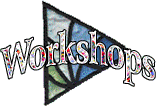Soon, I was spending more and more time in the classroom - sharing this all-consuming art. The patterns I taught were both innovative and traditional - usually constructed using contemporary methods. Eventually, I started traveling further afield teaching. I also joined the Canadian Quilters' Association (CQA/ACC) which added more momentum to my quilting journey.
In 1990, the two guilds in which I was involved agreed to host a national conference - Quilt Canada 1990 - with me as Chairperson. It was an awesome responsibility, and yet another stretching experience. Following the conference, I joined the Board of Directors of the CQA/ACC. This brought to me a great deal of work and I started to travel and expand my quilting family. My community of quilters had grown a great deal from those first days in Beaconsfield with the Thursday Group.
In 1992 I was the incoming president of the CQA/ACC. That same year I was selected as the Joseph Schneider Haus Museum’s 1992 Folk-Artist-in-Residence.
“The Folk Artist-in-Residence" programme has been sponsored since 1990 by the Friends of the Joseph Schneider Haus National Historic Site in Kitchener. It was designed to support the efforts of local artists and artisans working in traditional crafts and trades. Each year, the museum showcases the work of one such folk artist, promotes his/her trade and raises public awareness and appreciation for skills and hand-crafted items which might otherwise be lost to our heritage.
During the course of the year, the folk artist contributes to the ongoing programmes of the Museum in a variety of ways, which may include guest-curating an exhibition, hosting workshops, presenting lectures and demonstrations, and authoring booklets or catalogues.
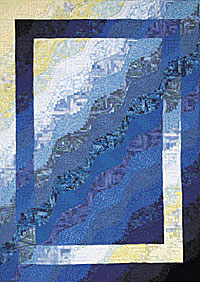 1992 became a very busy year for me. I became thoroughly involved with my new family - the Schneiders. The opportunity and the highlight of a one-woman show continued to add momentum to my life's journey. Part of my mandate as Folk Artist was to produce a quilt for the museum’s permanent collection. The only stipulation given was that it somehow be linked with the traditional quilts of Waterloo County. The log cabin was chosen, as it is a block I am particularly fond of and it fit the criteria. As you can see, I approached it as a colourwash quilt.
1992 became a very busy year for me. I became thoroughly involved with my new family - the Schneiders. The opportunity and the highlight of a one-woman show continued to add momentum to my life's journey. Part of my mandate as Folk Artist was to produce a quilt for the museum’s permanent collection. The only stipulation given was that it somehow be linked with the traditional quilts of Waterloo County. The log cabin was chosen, as it is a block I am particularly fond of and it fit the criteria. As you can see, I approached it as a colourwash quilt.
In spite of my volunteer responsibilities at the JSH and with the CQA/ACC, I managed to continue teaching. The teaching of quiltmaking is really my passion. The benefit to my career with these volunteer positions was that I became a known quantity, particularly in the Canadian quilting community, and was invited to teach more and more.
In 1993, I taught my first Magic Tiles classes in several quilt shops, which led to teaching it in a number of quilting guilds and conferences. The class became so popular that in the summer of 1995, with the encouragement of several shop owners and friends, I published the Magic Tiles pattern. It remains a very popular pattern today.
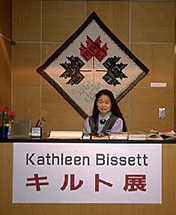 Also in 1993, I was invited to exhibit and lecture in Japan. The experience was most memorable. They, too, were intrigued with the Magic Tiles design and used it for the invitation to the Tokyo exhibit. For that exhibit I created a special Autumn Leaves collage quilt symbolizing the country from which I had traveled.
Also in 1993, I was invited to exhibit and lecture in Japan. The experience was most memorable. They, too, were intrigued with the Magic Tiles design and used it for the invitation to the Tokyo exhibit. For that exhibit I created a special Autumn Leaves collage quilt symbolizing the country from which I had traveled.
Since that time I have published three more patterns. My patterns grow out of popular classes and original designs. The second pattern, Garden Delight, started as a class I developed giving beginning quilters the opportunity to make beautiful large colourwash quilts with only their limited knowledge of quiltmaking. It was published in 1999 and continues to be in high demand.
In 1994, I had a small quilt, Star Dance, accepted in the CQA/ACC’s National Juried Show. It was a second in a series of modular quilts small enough to be displayed on a surface such as a coffee table. It is always intriguing to investigate the various block sets for a quilt. As quilters, we normally “audition” the position of our blocks before sewing them together. In my modular quilts, we don’t have to make that decision. For a number of years I was asked if there was a pattern available – particularly after it was featured on several Internet sites. In 2002 I published it and, very quickly, it gained popularity.
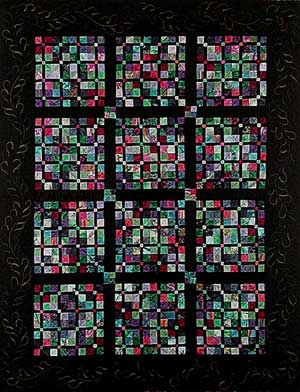 My fourth and final pattern developed out of a class, but not one of my classes. In April 2001, I took a class with my friend and colleague, Jim Wilford. Jim developed a design and technique that was so much fun that several of us in the class suggested that he publish it as a pattern. Jim said that he was not interested in the process of publishing – he was a teacher. After a number of discussions I learned that Jim really wished to have his pattern published, but he did not wish to do it himself. So, we agreed that I would purchase the rights to his design. Since the design was original with Jim, he automatically owned the copyright. As the owner he could sell that copyright. Once he sold the copyright to me, I was free to publish the design.
My fourth and final pattern developed out of a class, but not one of my classes. In April 2001, I took a class with my friend and colleague, Jim Wilford. Jim developed a design and technique that was so much fun that several of us in the class suggested that he publish it as a pattern. Jim said that he was not interested in the process of publishing – he was a teacher. After a number of discussions I learned that Jim really wished to have his pattern published, but he did not wish to do it himself. So, we agreed that I would purchase the rights to his design. Since the design was original with Jim, he automatically owned the copyright. As the owner he could sell that copyright. Once he sold the copyright to me, I was free to publish the design.
I have found that over the years copyright has become an important issue for quiltmakers. A couple of years ago a local quilt guild approached me to speak on the subject. I explained that although I had done a great deal of research and had taken part in a number of professional development seminars where we discussed and clarified copyright issues, I was not an intellectual property lawyer or expert, and could only speak on the subject from my own perspective.
Another exciting event in my quilting career was a voyage to Kunming, the capital of Yunnan province in the south of China, in 1999. My husband and I were part of an International Festival of the Arts where I had the opportunity to teach in the Yunnan Arts Institute and to exhibit several of my quilts. The Chinese students, too, were very interested in my Magic Tiles quilt and displayed it horizontally in a most unique way, like tiles on a floor.
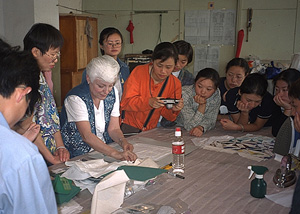 Preparing the classes for China offered new challenges. Although I had taught all the material before, now it had to be prepared for a Mandarin speaking class. I had wonderful interpreters, but seeing the techniques being done and illustrated on paper was also important. I prepared visuals of each technique with numerous steps and the handouts used graphics rather than words to explain the process.
Preparing the classes for China offered new challenges. Although I had taught all the material before, now it had to be prepared for a Mandarin speaking class. I had wonderful interpreters, but seeing the techniques being done and illustrated on paper was also important. I prepared visuals of each technique with numerous steps and the handouts used graphics rather than words to explain the process.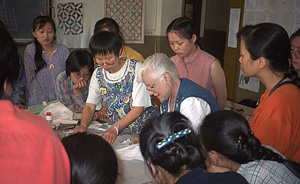
Each day I stressed that my aim was to provide them with a basic foundation in good quiltmaking techniques that would aid them in creating quality works of art using their own designs, which would reflect their own rich cultural heritage. I also explained copyright to them – that using someone else’s design for their own gain was a form of theft.
I continued teaching primarily in Canada and the United States for many years. For over a decade I taught a five-day seminar called Quilting à la Carte in the green mountains of Vermont. The seminar provided students the opportunity to “do their own thing.” From the menu provided, they selected the projects they would like to do and/or techniques they would like to learn during our days together.
Though my journey as a quiltmaker has included the exploration of the business and legal sides of quilting, about half of my time is spent in volunteer positions within the quilting or related communities. In 2006 I had the honour of curating the first Canadian show mounted at the Museum of the American Quilter's Society in Paducah Kentucky, Canada Uncovered. I continued to chair The Grand National Quilt Show in Kitchener, Ontario until 2017. The exciting news is that a group of fibre artists have taken on the Grand National with the intention of having it presented in various locations throughout the country. It has an altered name, The Grand National Fibre Art & Quilt Exhibition.
Over the years there have been some incredible highlights. One was the thrill of sharing a two-woman show at the Joseph Schneider Haus Museum with my daughter, Tara. At the timeTara was not a quilter, but painter of furniture and home accessories. Our individual and collaborative works were exhibited in a show called Kindred Threads: Patchwork Meets Painting in Bissett Family Art.
 A second wonderful experience was teaching a five-day Colour Exploration Class for the Canadian Embroiderers' Guild in London, Ontario. Since I am a long time member of the CEG, it was an unusual honour, as members of the guild are seldom asked to teach during the guild's summer workshop.
A second wonderful experience was teaching a five-day Colour Exploration Class for the Canadian Embroiderers' Guild in London, Ontario. Since I am a long time member of the CEG, it was an unusual honour, as members of the guild are seldom asked to teach during the guild's summer workshop.
The third incredible opportunity was teaching at the National Quilt Festival in Durban, South Africa in July of 2004. Not only did I teach, I had the opportunity to travel in this magnificent country. The trip was absolutely wonderful. The country is beautiful, interesting and varied. The animals were so great that I could have stayed watched them for weeks. But most of all, I was so impressed with the people. There are no limits to their kindness, hospitality and generosity.
Now retired, I never cease to be amazed at how interesting and rewarding my journey as a quilter has been. My greatest honour was being selected as the recipient of the Canadian Quilters’ Association’s 1998 Dorothy McMurdie Award for significant contributions to the world of Canadian quilting and Canadian quilt heritage.

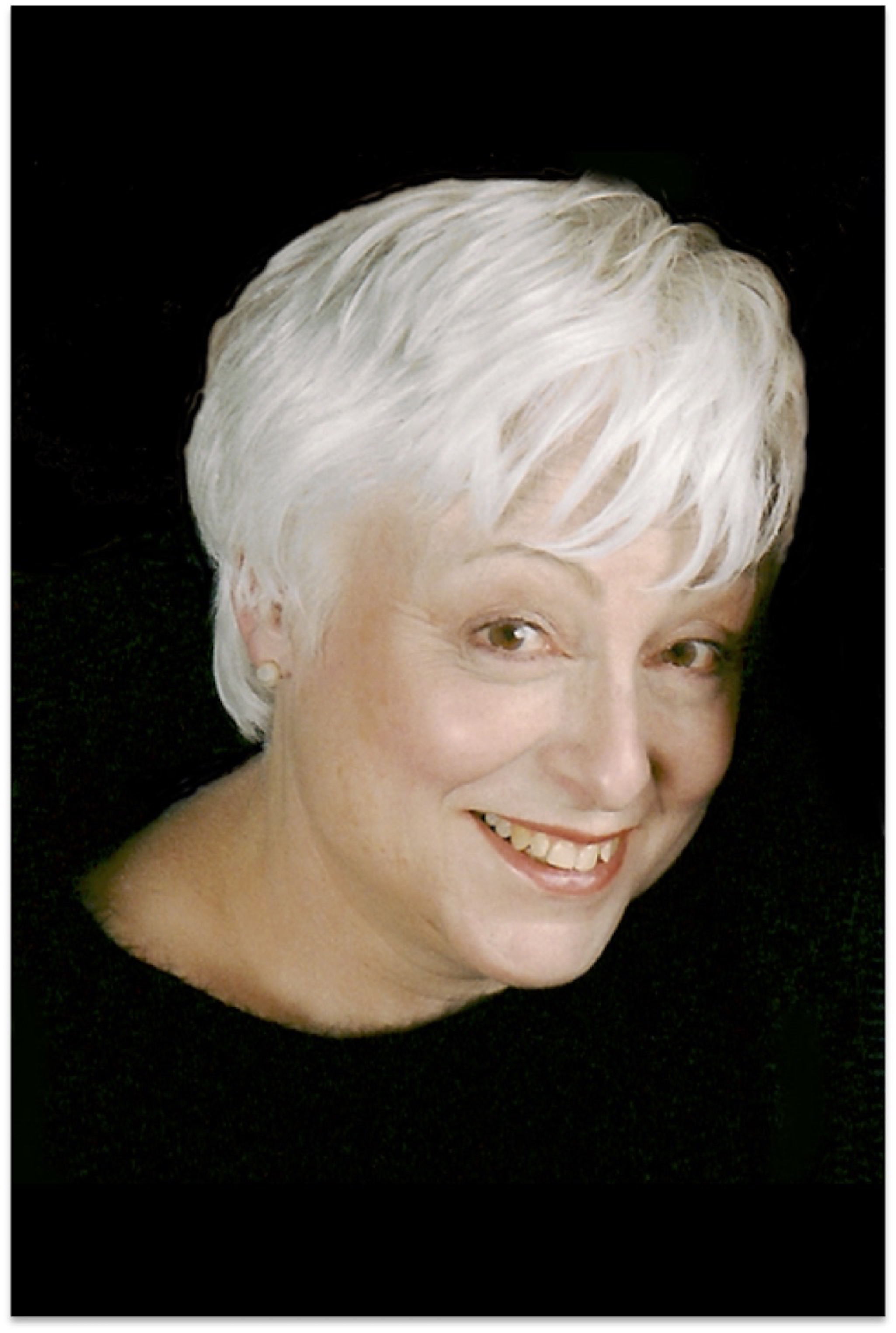
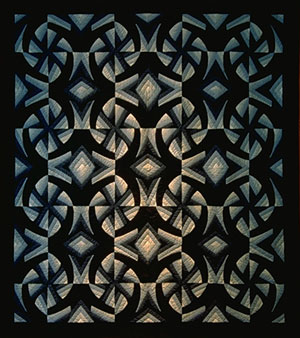 In the mid-eighties I was invited to participate in my first serious exhibition. I was thrilled to be considered an artist. The show was a combination of eight of the gallery's permanent collection of antique bed quilts with eight contemporary bed quilts made by artists belonging to the guild. The quilt I designed is called Moon on the Water. Its title is from a Japanese haiku:
In the mid-eighties I was invited to participate in my first serious exhibition. I was thrilled to be considered an artist. The show was a combination of eight of the gallery's permanent collection of antique bed quilts with eight contemporary bed quilts made by artists belonging to the guild. The quilt I designed is called Moon on the Water. Its title is from a Japanese haiku: 1992 became a very busy year for me. I became thoroughly involved with my new family - the Schneiders. The opportunity and the highlight of a one-woman show continued to add momentum to my life's journey. Part of my mandate as Folk Artist was to produce a quilt for the museum’s permanent collection. The only stipulation given was that it somehow be linked with the traditional quilts of Waterloo County. The log cabin was chosen, as it is a block I am particularly fond of and it fit the criteria. As you can see, I approached it as a colourwash quilt.
1992 became a very busy year for me. I became thoroughly involved with my new family - the Schneiders. The opportunity and the highlight of a one-woman show continued to add momentum to my life's journey. Part of my mandate as Folk Artist was to produce a quilt for the museum’s permanent collection. The only stipulation given was that it somehow be linked with the traditional quilts of Waterloo County. The log cabin was chosen, as it is a block I am particularly fond of and it fit the criteria. As you can see, I approached it as a colourwash quilt. Also in 1993, I was invited to exhibit and lecture in Japan. The experience was most memorable. They, too, were intrigued with the Magic Tiles design and used it for the invitation to the Tokyo exhibit. For that exhibit I created a special
Also in 1993, I was invited to exhibit and lecture in Japan. The experience was most memorable. They, too, were intrigued with the Magic Tiles design and used it for the invitation to the Tokyo exhibit. For that exhibit I created a special  My fourth and final pattern developed out of a class, but not one of my classes. In April 2001, I took a class with my friend and colleague, Jim Wilford. Jim developed a design and technique that was so much fun that several of us in the class suggested that he publish it as a pattern. Jim said that he was not interested in the process of publishing – he was a teacher. After a number of discussions I learned that Jim really wished to have his pattern published, but he did not wish to do it himself. So, we agreed that I would purchase the rights to his design. Since the design was original with Jim, he automatically owned the copyright. As the owner he could sell that copyright. Once he sold the copyright to me, I was free to publish the design.
My fourth and final pattern developed out of a class, but not one of my classes. In April 2001, I took a class with my friend and colleague, Jim Wilford. Jim developed a design and technique that was so much fun that several of us in the class suggested that he publish it as a pattern. Jim said that he was not interested in the process of publishing – he was a teacher. After a number of discussions I learned that Jim really wished to have his pattern published, but he did not wish to do it himself. So, we agreed that I would purchase the rights to his design. Since the design was original with Jim, he automatically owned the copyright. As the owner he could sell that copyright. Once he sold the copyright to me, I was free to publish the design. Preparing the classes for China offered new challenges. Although I had taught all the material before, now it had to be prepared for a Mandarin speaking class. I had wonderful interpreters, but seeing the techniques being done and illustrated on paper was also important. I prepared visuals of each technique with numerous steps and the handouts used graphics rather than words to explain the process.
Preparing the classes for China offered new challenges. Although I had taught all the material before, now it had to be prepared for a Mandarin speaking class. I had wonderful interpreters, but seeing the techniques being done and illustrated on paper was also important. I prepared visuals of each technique with numerous steps and the handouts used graphics rather than words to explain the process.
 A second wonderful experience was teaching a five-day Colour Exploration Class for the Canadian Embroiderers' Guild in London, Ontario. Since I am a long time member of the CEG, it was an unusual honour, as members of the guild are seldom asked to teach during the guild's summer workshop.
A second wonderful experience was teaching a five-day Colour Exploration Class for the Canadian Embroiderers' Guild in London, Ontario. Since I am a long time member of the CEG, it was an unusual honour, as members of the guild are seldom asked to teach during the guild's summer workshop. 

